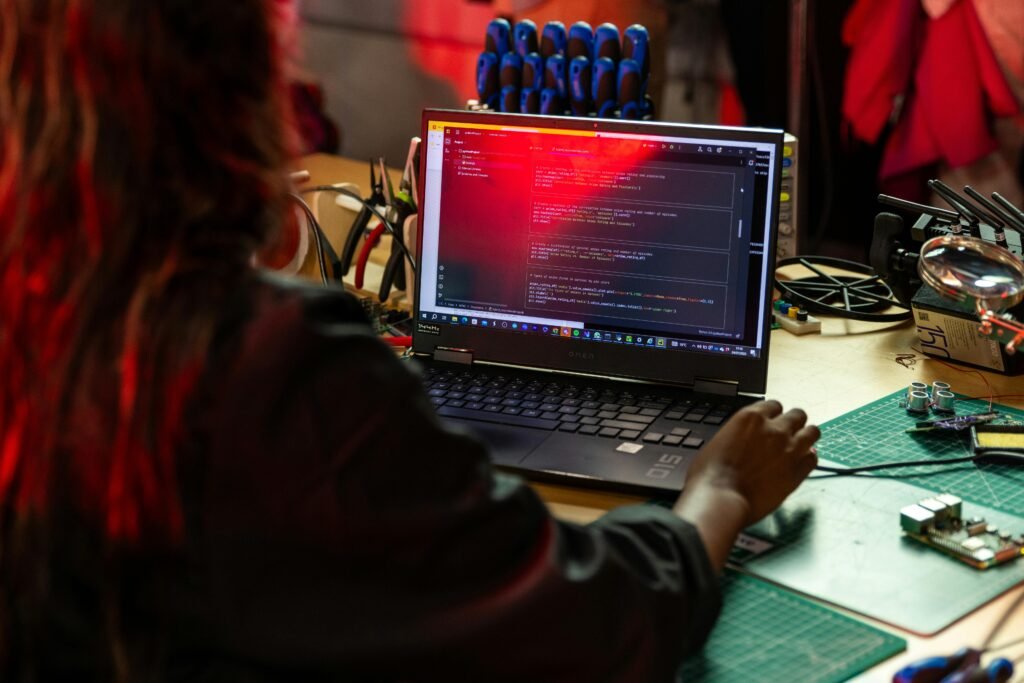Imagine a world where lights automatically adjust to our needs, creating the perfect ambiance for any situation. The future of lighting control systems holds the promise of transforming our homes, offices, and public spaces into personalized and energy-efficient environments. From smart bulbs that can be controlled with a simple voice command to advanced sensors that anticipate our lighting preferences, this article explores the exciting developments in lighting technology that are shaping the way we illuminate our lives. Get ready to witness an illuminating revolution!

1. Introduction to lighting control systems
1.1 Definition of lighting control systems
Lighting control systems refer to the technology and infrastructure that enable the management and control of lighting fixtures in various settings. These systems allow users to control the brightness, color, and timing of lights, providing enhanced efficiency, convenience, and customization.
1.2 Importance of lighting control systems
Lighting control systems play a crucial role in improving energy efficiency, reducing costs, and enhancing user experience in both residential and commercial settings. With the advancements in technology, these systems have become an integral part of smart homes, smart cities, and sustainable buildings.
1.3 Evolution of lighting control systems
Over the years, lighting control systems have evolved significantly. Initially, these systems relied on manual switches and dimmers to control lighting. However, with the advent of digital technology, wired and wireless control systems emerged, allowing for more advanced and flexible control options. Today, lighting control systems have become even more sophisticated, integrating with other technologies such as IoT, building automation, and artificial intelligence.
2. Types of lighting control systems
2.1 Wired lighting control systems
Wired lighting control systems utilize physical wiring to connect lighting fixtures with control devices. These systems are commonly used in new construction projects, as they require extensive wiring infrastructure during installation. They offer reliable and stable connectivity, making them suitable for large-scale installations, such as commercial buildings and industrial facilities.
2.2 Wireless lighting control systems
Wireless lighting control systems, on the other hand, operate using wireless communication protocols, eliminating the need for extensive wiring. These systems are highly flexible and can be easily retrofitted into existing spaces. They utilize technologies like radio frequency (RF), Zigbee, or Wi-Fi to communicate between lighting fixtures and control devices. Wireless control systems provide convenience and ease of installation, making them popular in residential applications.
2.3 Hybrid lighting control systems
Hybrid lighting control systems combine wired and wireless technologies, offering the benefits of both. They allow for a mix of wired and wireless control devices, providing flexibility and scalability. Hybrid systems are particularly useful in scenarios where a combination of new and existing lighting fixtures need to be integrated into a single control system.
3. Benefits of lighting control systems
3.1 Energy efficiency
One of the key advantages of lighting control systems is their ability to improve energy efficiency. These systems enable precise control over lighting levels, allowing users to dim or turn off lights when not needed. By reducing energy consumption, lighting control systems help lower utility bills and contribute to a more sustainable environment.
3.2 Cost savings
In addition to energy efficiency, lighting control systems offer significant cost savings over time. By optimizing lighting usage and reducing the need for manual intervention, these systems minimize maintenance and replacement costs. Additionally, features like occupancy sensors ensure that lights are only used when necessary, further reducing energy waste and associated expenses.
3.3 Customization and flexibility
Lighting control systems provide users with unprecedented customization and flexibility. With the ability to adjust the brightness, color, and timing of lights, users can create personalized lighting scenes to suit their preferences and needs. Whether it’s setting the perfect ambiance for a dinner party or creating a productive work environment, lighting control systems offer endless possibilities for customization.
3.4 Increased comfort and well-being
Effective lighting control systems can greatly enhance comfort and well-being. The ability to dim or adjust lighting levels can create a more relaxing atmosphere in living spaces or provide optimal lighting conditions for specific tasks. Additionally, advanced systems that incorporate human-centric lighting principles can mimic natural light patterns, positively impacting mood, productivity, and sleep quality.
4. Key components of lighting control systems
4.1 Lighting fixtures
At the core of any lighting control system are the lighting fixtures themselves. These fixtures can range from traditional incandescent or fluorescent lights to more advanced LED (Light Emitting Diode) fixtures. Proper selection and installation of lighting fixtures are essential for achieving desired lighting effects and energy efficiency.
4.2 Sensors and detectors
Sensors and detectors play a crucial role in lighting control systems by providing input and feedback to the system. Occupancy sensors detect the presence or absence of people in a given area and adjust lighting accordingly, ensuring lights are only used when needed. Other types of sensors, such as daylight sensors or motion detectors, further enhance the efficiency and responsiveness of the system.
4.3 Control devices
Control devices, such as switches, dimmers, keypads, or touch panels, enable users to interact with the lighting control system. These devices allow users to adjust lighting levels, select lighting scenes, or activate specific lighting zones. The choice of control devices depends on the complexity of the system and user preferences.
4.4 Communication networks
Communication networks form the backbone of lighting control systems, facilitating the exchange of information between lighting fixtures, sensors, and control devices. Wired systems utilize physical wiring infrastructure, while wireless systems rely on wireless communication protocols such as RF, Zigbee, or Wi-Fi. The reliability and range of communication networks are critical factors to consider for seamless system operation.
4.5 Software and programming
Software and programming are essential components for configuring and controlling lighting control systems. They allow users to define lighting scenes, set schedules, and automate system behavior. With intuitive software interfaces and user-friendly programming tools, configuring lighting control systems has become more accessible to end-users and system integrators.

5. Integration of lighting control systems with other technologies
5.1 Internet of Things (IoT)
The integration of lighting control systems with IoT enables a new level of connectivity and functionality. IoT-powered lighting systems can collect data from various sensors, allowing for more intelligent lighting control. Additionally, integrating with IoT platforms enables centralized control and monitoring of lighting systems, simplifying system management and optimization.
5.2 Building automation systems
Lighting control systems can seamlessly integrate with building automation systems, creating a holistic approach to facility management. By integrating lighting control with HVAC, access control, and other building systems, organizations can achieve higher levels of energy efficiency, occupant comfort, and operational efficiency.
5.3 Smart home technology
Lighting control systems are an integral part of smart home technology. They can be easily integrated with voice-controlled assistants, mobile applications, and home automation platforms. This integration allows users to control and monitor lighting systems remotely, create personalized lighting scenes, and automate lighting based on various triggers, enhancing convenience and comfort in the home environment.
5.4 Artificial intelligence (AI)
The integration of artificial intelligence (AI) with lighting control systems opens up new possibilities for intelligent and adaptive lighting. AI algorithms can analyze data from various sources, such as occupancy sensors, weather forecasts, or user preferences, to continuously optimize lighting levels and create dynamic lighting scenes. AI-powered lighting control systems can learn from user behavior and adapt lighting patterns accordingly, further enhancing comfort, energy efficiency, and well-being.
6. Current trends in lighting control systems
6.1 IoT-enabled lighting control
The adoption of IoT in lighting control systems is a growing trend. IoT-enabled lighting systems leverage the power of connectivity and data analytics to create smarter, energy-efficient environments. These systems can provide real-time energy consumption data, predictive maintenance alerts, and advanced lighting control features based on user preferences, occupancy patterns, or environmental conditions.
6.2 Voice control and virtual assistants
Voice control and virtual assistants have gained popularity in lighting control systems. With the integration of voice command technology, users can conveniently control lighting without physically interacting with control devices. Virtual assistants like Amazon Alexa or Google Assistant can interpret voice commands and communicate with lighting systems to adjust brightness, color, or activate predefined lighting scenes.
6.3 Human-centric lighting
Human-centric lighting, also known as circadian lighting, is an emerging trend in lighting control systems. This approach focuses on mimicking natural light patterns to support human well-being and performance. Human-centric lighting systems can dynamically adjust lighting color temperature and intensity throughout the day, aligning with the body’s natural circadian rhythm and promoting better sleep, increased focus, and improved mood.
6.4 Advanced data analytics
Using advanced data analytics techniques, lighting control systems can provide valuable insights and optimizations. By analyzing data collected from various sensors and sources, these systems can identify energy-saving opportunities, predict lighting maintenance needs, or offer personalized lighting recommendations. The integration of data analytics enhances the efficiency, performance, and user experience of lighting control systems.

7. Challenges and limitations of lighting control systems
7.1 Initial cost and installation complexity
One of the primary challenges of implementing lighting control systems is the initial cost and installation complexity. The infrastructure required for wired systems, such as extensive wiring and control panels, can add significant upfront expenses. Additionally, installation can be complex and time-consuming, especially for retrofit projects, which may require modifications to existing electrical systems.
7.2 Compatibility and interoperability
Compatibility and interoperability remain critical challenges when integrating different lighting control systems or components from various manufacturers. Incompatibilities between control devices, communication protocols, or software interfaces can hinder seamless integration and system operation. Standardization efforts and open protocols, such as DALI (Digital Addressable Lighting Interface), aim to address these challenges and ensure compatibility between different lighting control systems.
7.3 Security and privacy concerns
The integration of lighting control systems with other technologies increases the importance of security and privacy considerations. Lighting control systems, connected to IoT platforms or accessible remotely, may be vulnerable to cyber-attacks or data breaches. Appropriate security measures, such as secure communication protocols, encryption, and user authentication, must be implemented to protect the privacy and integrity of lighting control systems.
7.4 Maintenance and system updates
Maintenance and system updates can be challenging for lighting control systems, especially in large-scale installations or complex environments. With multiple components and interconnected systems, regular maintenance is essential to ensure optimal performance. Software updates, firmware upgrades, and hardware replacements may be required periodically to address system vulnerabilities, introduce new features, or incorporate technological advancements.
8. Case studies and successful implementations
8.1 Energy-efficient lighting in commercial buildings
Numerous commercial buildings have successfully implemented lighting control systems to achieve energy efficiency and cost savings. By combining occupancy sensors, daylight harvesting, and scheduling capabilities, these systems adapt lighting levels based on occupancy and natural lighting conditions. Case studies have shown significant energy savings, improved occupant comfort, and reduced maintenance costs in commercial office spaces, retail stores, and educational facilities.
8.2 Smart lighting in smart cities
Smart city initiatives incorporate lighting control systems to enhance urban sustainability and safety. Intelligent street lighting systems can dynamically adjust lighting levels based on pedestrian or vehicular activity, reducing energy waste while ensuring public safety. Moreover, these systems can integrate with other urban sensors and technologies, such as smart parking or environmental monitoring, to create a comprehensive and interconnected smart city infrastructure.
8.3 Residential lighting control systems
Residential lighting control systems have gained popularity among homeowners seeking convenience, energy savings, and comfort. These systems allow users to control lighting throughout their homes using mobile applications, voice commands, or centralized control panels. By creating specific lighting scenes for different activities and automating lighting schedules, residents can enhance ambiance, save energy, and facilitate easy management of their lighting systems.

9. Future advancements in lighting control systems
9.1 Advancements in LED technology
The continuous advancements in LED technology promise further improvements in lighting control systems. With the ability to fine-tune color temperature, adjust color saturation, and improve overall efficiency, LED fixtures will continue to be at the forefront of lighting control. Additionally, innovations such as OLED (Organic Light Emitting Diode) technology and microLEDs show potential for more flexible and visually appealing lighting solutions.
9.2 Integration with renewable energy sources
Future lighting control systems may seamlessly integrate with renewable energy sources, such as solar panels or wind turbines, to enhance sustainability. By managing lighting usage based on renewable energy availability, these systems can further reduce carbon footprint and reliance on traditional energy sources. Integrated energy management with storage capabilities may enable lighting systems to contribute to overall energy self-sufficiency in buildings and smart grids.
9.3 Gesture and occupancy-based control
Advancements in sensor technology, including image recognition and 3D depth sensing, may enable gesture-based control of lighting systems. Users could interact with lighting fixtures by simply waving their hands or making specific gestures, enhancing convenience and accessibility. Furthermore, occupancy detection and recognition systems may become more sophisticated, allowing for individualized lighting control based on personal preferences and behavior patterns.
9.4 Artificial intelligence-based optimization
The integration of artificial intelligence and machine learning into lighting control systems holds significant potential for optimization and automation. AI algorithms can learn from occupants’ preferences, environmental conditions, and historical data to automatically adjust lighting levels, anticipate lighting needs, and optimize energy usage. Such systems can also detect anomalies, predict maintenance requirements, and continuously adapt to changing user demands, ensuring optimal lighting performance and user experience.
10. Conclusion
10.1 Summary of key points
Lighting control systems have evolved from manual switches and dimmers to sophisticated, intelligent systems that offer energy efficiency, cost savings, customization, and enhanced comfort. With wired, wireless, and hybrid options available, these systems can be tailored to different settings and requirements. Key components, integration with other technologies, and the latest trends contribute to the continuous advancement of lighting control systems.
10.2 The future outlook for lighting control systems
The future of lighting control systems looks promising, with advancements in LED technology, integration with renewable energy sources, gesture-based control, and AI-based optimization on the horizon. These advancements will further enhance energy efficiency, user experience, and sustainability. However, challenges related to initial cost, compatibility, security, and maintenance must be addressed to maximize the benefits of lighting control systems. As technology continues to evolve and user demands evolve, the possibilities for lighting control systems are vast, paving the way for a brighter and smarter future.



